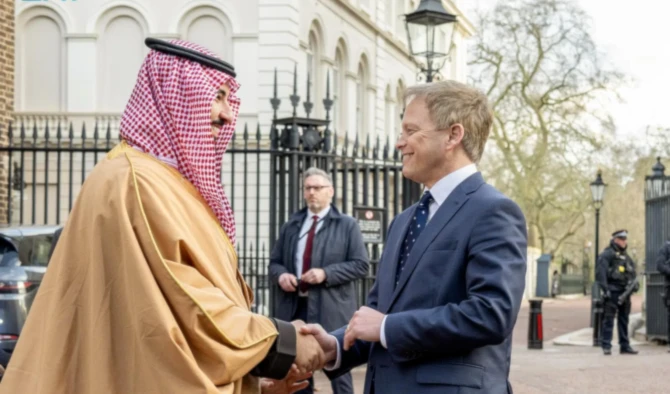UK Royal Navy faces historic low with only two operational destroyers
The UK Royal Navy’s fleet is down to just two operational Type 45 destroyers, with four undergoing extensive repairs.
-

An HMS Defender, a type 45 air-defense destroyer ship, stands in the Mumbai International Cruise Terminal during the Royal Navy and Indian Navy meet in Mumbai, India, Oct. 22, 2021. (AP)
A new report by The Telegraph highlights critical vulnerabilities in the UK's military readiness, with a severely diminished naval fleet and insufficient manpower, raising concerns about the nation's ability to defend itself in a potential large-scale conflict.
The British Royal Navy's destroyer fleet has reached historic lows with only two of its six advanced Type 45 destroyers operational, The Telegraph reported, citing the UK Ministry of Defense.
Four of the vessels are undergoing extensive repairs, leaving the fleet at its smallest size in over a century. Significantly, the report explained that the Type 45 destroyers, the "backbone of the Royal Navy’s air defense capabilities," have been plagued by numerous maintenance issues. One ship has spent more time in repairs than in service since its commissioning 12 years ago, the report revealed.
"These reports of only two operational destroyers are extremely concerning," said MP Mike Martin, adding, "Destroyers provide air defense and with only two destroyers, we simply cannot defend London, let alone the United Kingdom."
According to the UK Ministry of Defense, cited in the report, the fleet has dropped to a critical point, with just eight out of 14 destroyers and frigates available for immediate deployment, compared to more than 800 ships during the Navy’s peak in 1945. Additionally, only six of the eight Type 23 frigates are operational.
The situation has raised concerns about the UK's readiness for large-scale conflict. Alistair Carns, a British Ministry of Defense official, admitted, "The UK is not prepared to fight a war on the scale of the Ukraine conflict," noting that the country would run out of soldiers within six months to a year in a major war. The British Army currently has just over 73,000 active-duty soldiers, the lowest since 1823, despite the UK's population growing from 20 million to 67 million.
Navy enlistment crisis impedes sending UK aircraft carriers to Red Sea
Earlier this year, The Telegraph also reported that Britain's aircraft carriers are not ready to deploy to the Red Sea due to a recruitment issue in the Armed Forces.
The Yemeni SABA news agency in Sanaa reported Friday that the American-Israeli-British aggression launched multiple airstrikes on the capital Sanaa and the provinces of Hodeidah, Saada, and Dhamar, and Rishi Sunak has recently warned that the country would "continue to take action" if the Yemeni Armed Forces (YAF) did not de-escalate their attacks in the Red Sea.
The second day, the US renewed its aggression on Yemen targeting an airbase north of Sanaa.
The US Central Command (CENTCOM) confirmed on Saturday that US forces carried out a strike that targeted an alleged radar site used by the Ansar Allah movement in Yemen.
"This strike was conducted by the USS Carney (DDG 64) using Tomahawk Land Attack Missiles and was a follow-on action on a specific military target associated with strikes taken on Jan. 12 designed to degrade the Houthi’s ability to attack maritime vessels, including commercial vessels," CENTCOM said in a statement on X.
HMS Queen Elizabeth, the UK's £3 billion aircraft carrier, might be sent to the region as part of the Carrier Strike Group (CSG), which includes modern warships, submarines, helicopters, and fifth-generation fighter fighters.
However, The Telegraph knows that RFA Fort Victoria, the sole Solid Support Ship capable of supplying the CSG with the necessary ammunition, planes, spare equipment, and food for a complete deployment, is unable to sail due to a shortage of personnel.
The ship typically has a 100-person crew but is now operating with a smaller crew, and although it has no mechanical issues, it remains in Liverpool's Cammell Laird shipyard, despite being scheduled to return to the ocean last year after major repairs since its voyage with the CSG to the Indo-Pacific in 2021.
It is believed that the Navy has prioritized crewing other Royal Fleet Auxiliary vessels over RFA Fort Victoria, such as tankers that provide fuel for ships and bay class landing crafts that bring humanitarian relief and serve as a mothership for mine-hunting vessels.
Lord West, the former First Sea Lord, called the vessel's neglect "atrocious" and emphasized that Fort Victoria ought to have been of higher priority.
UK defense officials claim there are other ways to support the carriers if the cruiser is dispatched to the region, including collaborations with other nations to get adequate supplies and transferring sailors from other merchant navy boats to RFA Fort Victoria, although this would need training time.
Read more: UK engineers used Russian, Belarusian software for submarines

 5 Min Read
5 Min Read











